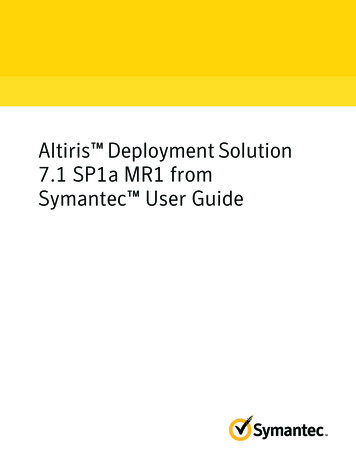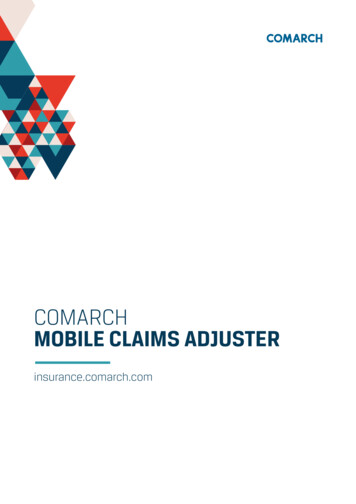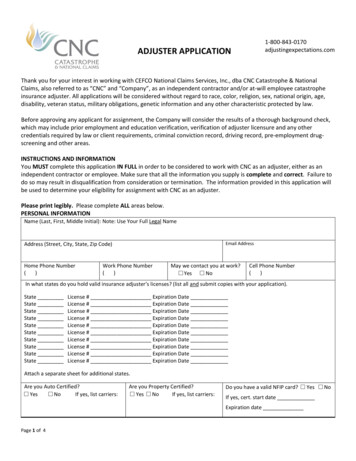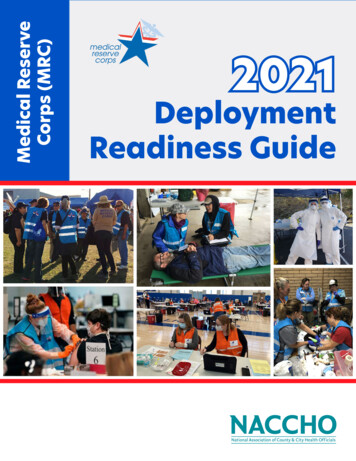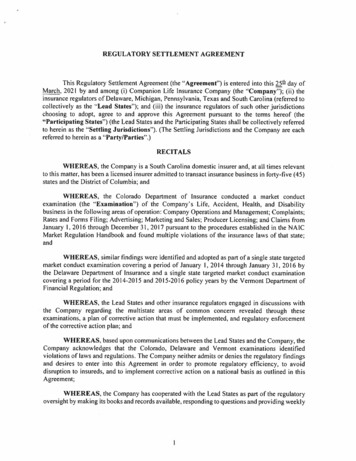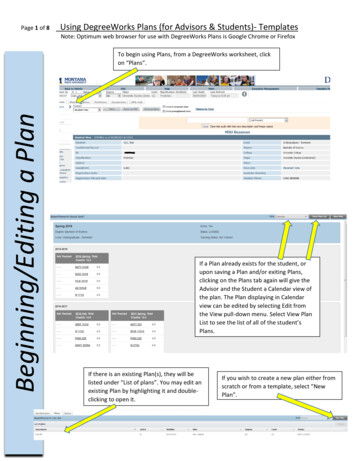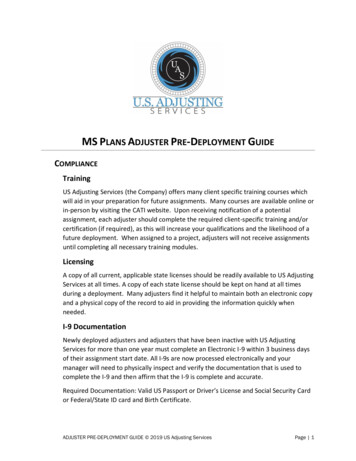
Transcription
MS PLANS ADJUSTER PRE-DEPLOYMENT GUIDECOMPLIANCETrainingUS Adjusting Services (the Company) offers many client specific training courses whichwill aid in your preparation for future assignments. Many courses are available online orin-person by visiting the CATI website. Upon receiving notification of a potentialassignment, each adjuster should complete the required client-specific training and/orcertification (if required), as this will increase your qualifications and the likelihood of afuture deployment. When assigned to a project, adjusters will not receive assignmentsuntil completing all necessary training modules.LicensingA copy of all current, applicable state licenses should be readily available to US AdjustingServices at all times. A copy of each state license should be kept on hand at all timesduring a deployment. Many adjusters find it helpful to maintain both an electronic copyand a physical copy of the record to aid in providing the information quickly whenneeded.I-9 DocumentationNewly deployed adjusters and adjusters that have been inactive with US AdjustingServices for more than one year must complete an Electronic I-9 within 3 business daysof their assignment start date. All I-9s are now processed electronically and yourmanager will need to physically inspect and verify the documentation that is used tocomplete the I-9 and then affirm that the I-9 is complete and accurate.Required Documentation: Valid US Passport or Driver’s License and Social Security Cardor Federal/State ID card and Birth Certificate.ADJUSTER PRE-DEPLOYMENT GUIDE 2019 US Adjusting ServicesPage 1
EQUIPMENTComputerEach adjuster must provide their own Windows-based laptop computer capable ofrunning Xactimate 28. The computer should be reliable and in good operatingcondition. Access to an alternative computer and data backup is highly recommended.Keep in mind that the cost of downtime or loss of data will quickly exceed that of themachine.TabletXactware offers Xactimate 28 on multiple platforms and can be used with multipledevice types. While the mobile application can be immensely useful, it should not berelied upon as a primary device for estimate preparation and cannot serve as areplacement for a laptop computer. Refer to the Xactimate 28 System Requirementslink for more detail on the system requirement.Mobile PhoneAn internet capable smart phone is required.Xactimate 28 Estimating PlatformThe most current version of Xactimate 28 is the only estimating platform used by USAdjusting Services. Each adjuster will be required to maintain an active license of theapplication for the duration of the event. As an added benefit of working for USAdjusting Services, our adjusters may secure an active 30-day license at a discountedrate of 180.00 - 190.00 (after taxes) per month and is charged as a monthly payrolldeduction. For additional details, please contact your manager.When registering the software, each adjuster should keep record of the registeredKeyCode, Xactnet Address and Xactware ID used during the registration process. Thisinformation will be required during the onboarding process upon deployment.Additional Software RequirementsMicrosoft Office 365 (MS Word and Excel)Tools of the TradeThe following tools will be necessary for a successful deployment. Each adjuster shouldmaintain their equipment in good working order to ensure safety while deployed. One-story and two-story ladderTape measures (retractable 25-35ft, long tape 100ft and measuring wheel)Pitch gaugeADJUSTER PRE-DEPLOYMENT GUIDE 2019 US Adjusting ServicesPage 2
Metal roofing gaugeComposition shingle gauge (adjusters should have both the 1/12 and 4/09models on hand)Chalk and/or soap stoneShears or razor knife (used for siding and carpet samples)Flashlight/ headlampFootwear appropriate to access roofs. Cougar Paws are highly recommendeddue to the added safety that they provide the adjuster when accessing highslope roof surfaces.APPARELShirtCompany shirts with collars are required. In cases where Company shirts are notavailable, collared shirts without logos are required. Company apparel should not to beworn in a social setting or during non-working hours.SlacksKhaki pants or slacks are required.ShoesAppropriate closed toe shoes are required.HatsWe understand that while working on a roof under direct sunlight and heat you maywish to wear a cap. A Company hat is permissible. If a Company hat is not available, it ispermissible to wear a hat without any other logo, including sports or beverage logos.Hats and caps should be clean and free from holes, frays, etc. and should be removedwhen entering the insured’s home or office.ADJUSTER PRE-DEPLOYMENT GUIDE 2019 US Adjusting ServicesPage 3
ADJUSTER ONBOARDING GUIDEPROFESSIONAL EXPECTATIONSAppearance StandardsUS Adjusting Services serves important and high-profile clients and believes that theappearance of our employees reflects our overall professional stature. Therefore, theCompany requires a neat and well-groomed appearance for all employees.Denim pants, shorts or non-collared shirts are not permitted while in client facilities, in atemporary CAT office or while in the field on inspections. Khaki pants or slacks withappropriate shoes and Company shirts with collars are required. In cases whereCompany shirts are not available, collared shirts without logos, including sports teamlogos, are required. Company apparel should not to be worn in a social setting or duringnon-working hours.Conduct StandardsAs an adjuster working on behalf of US Adjusting Services, you have a specialresponsibility to uphold and ensure that the respectability of our company and ourprofession is diminished. Accordingly, it is important to continuously be aware of yourconduct while on assignment. At every stage of the claim handling process, our conductaffects the way our professionalism and ethics are viewed by our clients, theircustomers, and our peers.Ultimately, the responsibility for proper conduct rests with each of us. There is nosubstitute for personal integrity and good judgment. When faced with a difficultsituation, consider these questions: Is my action or decision the right thing to do?Could my action or decision withstand public scrutiny?Will my action or decision protect US Adjusting Services’ reputation as anethical company?US Adjusting Services expects and requires positive and pleasant attitudes andinteractions with policyholders, clients and co-workers.It is expected that you will conduct yourself in a professional manner in all situations.Many aspects of our profession take place under high-stress circumstances that caneasily cause adjusters to have a lapse of judgment. You will be expected to exercisepatience in all situations, and not let emotions overtake your words or actions.US Adjusting Services has a zero-tolerance policy for violence and/or harassment.ADJUSTER PRE-DEPLOYMENT GUIDE 2019 US Adjusting ServicesPage 4
Conflicts of InterestAdjusters must avoid any situation where a conflict could exist or appear to existbetween one’s personal interests and US Adjusting Services or our clients. Adjustersshould avoid any outside financial interest that might influence decisions or actions onbehalf of the US Adjusting Services or our clients. If you are unsure about a potentialconflict, discuss the circumstances with your manager.Adjusters should also avoid outside activities that encroach on working time, interferewith regular duties, adversely affect the quality of work performed, or negatively affectUS Adjusting Services or its client reputations.Adjusters should never recommend a specific contractor. If asked to recommend acontractor by a client (not a policyholder), provide at least three contractors names witha disclaimer that you are not endorsing any one specific contractor. There may be timesthat the client provides a list of recommended contractors. The client and/or USAdjusting Services management will provide any such information in written form.Riding with a contractor, or having a contractor ride with you, is strictly prohibited. Anyadjuster suspected of having an improper agreement with a contractor will be dismissedfrom duty immediately pending investigation into the matter.Perceived Conflicts of InterestThe appearance of impropriety can be as damaging as an actual impropriety. Once youare viewed as not having the best interest of the insured in mind, it will be very difficult,if not impossible, to undo that perception.SAFETY & ONSITE INJURYYour safety is our top priority. Keep these basic safety tips in mind: Never set up your ladder on wood decks, or any slippery surfaceBe aware of your safety around dogs and other animalsAlways be aware of your surroundings.Do allow contractor/Insured to access your ladderFor more information about safety, please refer to the US Adjusting Services AdjusterSafety course which is available in the US Adjusting Services Learning Center.If you do sustain an injury on the job, please take whatever steps are reasonable toobtain the necessary medical treatment and contact your US Adjusting Servicesmanager immediately. If your manager is not available, please call the office and speakto Brandy Contreras.ADJUSTER PRE-DEPLOYMENT GUIDE 2019 US Adjusting ServicesPage 5
ORGANIZATIONAL STRUCTUREClaims OperationsAllen Gentry – Vice President Claims OperationsGreg Wasinger – Director Catastrophe OperationsNilsa Arroyo – Account Claims Manager/Quality AssuranceNick Berger – Large Loss SpecialistPam Crockett – Catastrophe and Field ManagerClaims AdministrationColby Hollingsworth – Claims Administration/ExaminerJohn Simonelli – Claims Administration/Catastrophe TPA Team Lead/ExaminerQuality AssuranceFile examiners assigned to an operation are responsible for reviewing completed claimfiles returned by the field adjuster. The review will ensure that an accurate andcomplete claim file has been prepared prior to submission to the client. Minor errors incalculation, estimate omissions or grammatical errors may be resolved by collaboration.Assignments will be returned to the adjuster if they are incomplete or contain moresignificant errors or omissions. Managers will address patterns of work that do not meetstandards with the adjuster and develop a performance improvement plan. A lack ofdemonstrable improvement may result in limited or terminated future assignments.Where appropriate, an estimate may be elevated to management for a secondaryreview.PERFORMANCE EXPECTATIONSProduction ExpectationsGenerally, inspections should be completed in the order in which the assignments arereceived. However, various other factors should be given consideration whenprioritizing assignments. For example, severity of the damage, time since the initial lossreport was filed and length of time the assignment has been assigned to field forhandling may require higher priority.US Adjusting Services and our clients require that an accurate and detailed log of claimhandling activity be maintained at all times. US Adjusting Services also requires thatassignments be submitted promptly upon completion of the investigation. It is ourADJUSTER PRE-DEPLOYMENT GUIDE 2019 US Adjusting ServicesPage 6
expectation that an adjuster will only perform the number of property inspections thatcan be promptly completed and submitted for review. Over-inspecting leads to adecrease in quality and an unacceptable delay in concluding the claim for thepolicyholder. Over-inspecting also creates an unnecessary backlog that will be difficultto overcome. During the deployment, if at any time you begin to feel overwhelmed orare having difficulties managing your workload, please visit with your US AdjustingServices manager. An action plan can be provided to assist if timely notification isprovided. Please do not wait until it is too late and the situation can no longer beeffectively resolved.In general, we expect that files be submitted for review the same day the inspection iscompleted. If a claim is withdrawn by the policyholder at the time of the initial contact,the file note should be updated accordingly, all necessary documentation completedand submitted for review immediately.Quality ExpectationsEach file should be submitted only after all the required documentation has beenprovided. Please refer to the client-specific list of file requirements for a detailedoutline of the necessary documents. The adjuster should review each document forcompleteness and accuracy before submitting the assignment for review. Each adjusterwill be accountable for the quality of their work product. Files that are returned forrevision will be monitored and if necessary, may require management assistance tocontinue the assignment.Inventory ManagementThe adjuster should maintain an 80% closed to inspected ratio at all times.ADJUSTER PRE-DEPLOYMENT GUIDE 2019 US Adjusting ServicesPage 7
ADJUSTER FIELD GUIDESERVICE LEVEL TARGETS:Service Level Targets—Daily Claim EnvironmentWhen operating under a normal daily claim operation, the adjuster must be mindful ofany applicable time-based service level targets US Adjusting Services has with the goalof handling all claims within the expected time lines for the completion of each stage ofthe claim handling process. Following major catastrophes, the client may alter thesetimelines based upon the volume of claims and severity of damage. Writtencommunication from the responsible Claim Manager will be provided for any deviationfrom the below table.The following table outlines the Service Level Targets (SLT) and the Service Level Goals(SLG).Start TriggerEnd TriggerServiceLevel GoalSLT-1Client DeliveredAssigned6 HoursServiceLevelTarget12 HoursSLT-2Client DeliveredContacted12 Hours24 HoursSLT-3ContactedInspected72 Hours72 HoursSLT-4InspectedReturned12 Hours24 HoursSLT-5ReturnedReviewed12 Hours12 edRevisionReturnedReviewed12 Hours12 Hours12 Hours12 HoursClient Returned144 Hours(6 Days)168 Hours(7 Days)SLT-7SLT-8CLAIM PROCESS OVERVIEWClaim DeliveryThe client will deliver assignments to US Adjusting Services electronically by using TheCompany’s Claims Management System. The assignments will remain in the assignmentqueue until assignment by US Adjusting Services management to the appropriate fieldadjuster. This process timeline will correspond to SLT-1 as shown on the table above.Claim ContactThe Field Adjuster will make contact with the policyholder within 24 hours of receivingthe assignment. The Field Adjuster will update the Activity Report with each attempt toADJUSTER PRE-DEPLOYMENT GUIDE 2019 US Adjusting ServicesPage 8
contact, providing the phone number that was called and enter a note detailing theattempt. The contact timeline should be documented in the GLR submitted to theExaminer.This process timeline will correspond to SLT-2 as shown on the table above.Claim InspectionInspection should be made within 3 days from receipt of the claim. Update the claimnotes to the inspection findings, whom you met with, any pending items that may existand set expectations and next steps. The Field Adjuster should provide the insured withyour business card at the time of inspection.Claim ReturnThe estimate should be submitted within 24-48 hours of inspection. If extenuatingcircumstances do not allow for this, the notes must clearly explain why and, if delayedover 7 days, a status report will be required.Claim ReviewClaim review will be conducted by the Quality Assurance Group.Claim RevisionA file returned for revisions must be a top priority. A field adjuster should complete andresubmit the revised estimate within 12 hours of receipt, no later than the same dayreceived. If the adjuster questions the requested revision(s) they may need to contactthe desk adjuster or their manager to discuss.Claim Approval/ Client SubmissionWhen the file has been reviewed and approved by the US Adjusting Services fileexaminer, the examiner will need to contact the insured to review the settlement of theclaim. The activity notes need to be updated to reflect this conversation.GENERAL FIELD GUIDELINESInitial ContactInitial contact is required on the same day as, or less than 24 hours from assignment. Itis critical that the adjuster contact the insured as soon as possible in order toappropriately triage the assignment and assist the insured in their next steps,particularly regarding the protection of their property from further damage.ADJUSTER PRE-DEPLOYMENT GUIDE 2019 US Adjusting ServicesPage 9
Temporary or Emergency RepairsThe need for emergency services, mitigation, and other temporary repairs should beaddressed both at the time of initial contact and during the inspection in order toensure the property is protected from further loss as well as to provide the insured withneeded peace of mind. A loss has been suffered, direction and empathy should bedemonstrated by the Field Claims Adjuster to reassure and help the insured. FieldClaims Adjusters should ask the insured on first contact:1. Can the property and its contents be secured?2. Is there a tree on covered property that needs to be removed?3. Does the property still have full access to utilities, specifically electricity andwater?4. Is there water damage inside the property which needs to be mitigated toprevent further damage?5. Are other temporary repairs or mitigation needed to further protect theproperty (such as board-up of windows, tarp on roof, etc.)?The adjuster should make note as to whether the insured is able to still inhabit thehome or whether there is a need for advanced payment and/or ALE. In such casescommunication with the Claims Examiner should happen immediately so thatemergency services, board-up, ALE, and anything else the property owner requires canbe secured. A recommendation for an advanced payment should be provided as well asany reserve recommendations. This initial conversation should be fully documented inthe adjuster General Loss Report as well.Explain that permanent repairs should not be made before the property is inspected sothe Field Claims Adjuster can see the damage and determine if it was caused by acovered peril. Ask the insured to provide accurate records, receipts, pre-repair photos,or other documentation for any temporary repairs.Adjusters should estimate for any temporary repairs or mitigation needed in the case ofstorm created openings to prevent further additional damage, regardless of whetherthe repairs have been completed at the time of inspection.Tree RemovalCoverage for debris removal on the MWUA and MRPIUA policies applies to the debris ofcovered property only. As trees are specifically excluded, coverage for removal of treedebris is not covered by the policy.Coverage does apply to remove the tree from covered property (cut and drop) in orderto complete repairs.ADJUSTER PRE-DEPLOYMENT GUIDE 2019 US Adjusting ServicesPage 10
If the tree needs to be removed to mitigate any further damages before the Field ClaimsAdjuster is able to perform the inspection, ask the insured to take pictures and keepreceipts.If the tree has not yet been removed at time of inspection, as much of the propertyshould be inspected as possible and a preliminary inspection report and estimateprepared. An estimate should be written for the removal of the tree and and theExaminer notified of the need for tree removal and possible advance payment formitigation of further damage subject to the deductible.If additional questions or concerns arise, please consult the MS Plans Claims Examinerassigned to the loss.InspectionInspection is expected to take place within 48 hours of Initial Contact. In order toensure all damages are addressed during the initial inspection, ideally the property willbe inspected with the insured or insured’s representative present. If the insuredconfirms damage is limited to the exterior and gives permission to inspect without beingpresent, the adjuster may do so and should document the file accordingly. If theinspection cannot be completed within that time frame, put a comment in your filenotes explaining the reasons why you were unable to do so.Properly greet and introduce yourself to the insured or their representative. Include anexplanation of why you are there and what they can expect from your visit andinspection.Walk the entire property with insured or their representative. Allow them to point outany and all claimed damages. Point out any damages you observe that the customerdoes not and confirm whether they intend to make the damage part of their claim.Document and address contents during your inspection if there is potential contentsloss. Assess possible need for mitigation or temporary repairs during the inspection.Close your inspection by sharing the next steps of the claims-handling process. End theinspection by asking the customer if there is anything else they would like to presentand if your inspection has lived up to their expectations.Your dress should meet business casual standards and be professional and practical.Denim pants are not permitted. Wear shoes or boots that provide adequate traction fortraversing a multi-pitched roof.ADJUSTER PRE-DEPLOYMENT GUIDE 2019 US Adjusting ServicesPage 11
ReportsStatus ReportWhen there is difficulty in contacting or scheduling with an insured, provide a statusreport in the form of a note submitted in the Company’s Claims Management Systemand emailed to the MS Plans Claim Examiner every 7 days from the claim assignmentuntil the loss is resolved. Claim Examiners are expected to return any contact from theField Adjuster within 24 hours, if requested.If there are extenuating circumstances (i.e. the insured is out of the country, extensivedamage found, etc.) contact your manager to determine if an initial report is needed.Initial/ Final ReportInitial or Final Reports are expected to be provided within 24-48 hours of the inspection.File DocumentationFile activity notes should be maintained on all MS Plans claim files. Examiner willdocument all activities in InsuranceNow from first receipt of the assignment to finalreport submission. Any documentation or evidence the Field Claims Adjuster obtainsrelated to the claim should be evaluated, responded to, included in their file, andprovided to MS Plans.To Be Included in the Field Claims Adjuster Report (PDFs): One copy of your invoice Activity Log (including T&E log) Field Claims Adjuster’s General Loss Report ITV from Xactimate (RCV & ACV amounts) Loss Recap Building/Personal Property Worksheet (estimate/inventory) Field Claims Adjuster’s Photo Sheets (labeled) Documents received from insured, including e-mails, estimates, invoices,receipts, photos, advance payment requests Copies of letters/e-mails sent to insuredAll documents generated out of Xactimate should use the default naming conventionset by Xactimate.Photo RequirementsClear digital photos are required. Photos should be numbered, identified by the buildingor item number and room/area, and include a description. Enough photographs shouldbe taken to adequately document the damaged as well as the undamaged portions ofthe item.ADJUSTER PRE-DEPLOYMENT GUIDE 2019 US Adjusting ServicesPage 12
Overview and close-up photographs should be taken of all areas of damage and relevantareas with no damage.Photo descriptions should be factual, free from speculation or opinion, and sufficientlydescriptive to allow the inside examiner to identify what is being depicted in the photoand where on the property the photo is located. Submit the following photos on alllosses: Elevation photos - north, south, east, west elevations of the risk Overview of all slopes and test squares Close-up photos of most severely damaged shingle(s) Photos demonstrating damage or lack thereof to soft metals, screens, gutters,etc. Photo of metal roofing gauge tool on all metal roofs Photos of shingle gauges are not required but type of shingle should bedocumented in every case Pitch gauge on roof Photos showing evidence of single or multiple layers of roofing Photos showing presence of drip edge and valley metal if included in estimate Interior attic showing type of roof decking Interior attic showing any evidence of interior damage or ongoing leakso NOTE: a photo of the HVAC system condensation pan (drip pan) isneeded when interior water damage is reported/claimed near thecondensation pan. Overview of all interior rooms and a close-up photo of damaged areaso At least 2-corners overviews should be taken, 4-corners whereappropriateo Overviews should include floor, walls and ceiling for each view Personal Property when applicable Roofs of other nearby structures to document damage or no damageThe Estimate should be written in the same order that the photos are taken above.Diagramming and Measurements Diagrams with measurements are required on all field adjusted losses.The computer-generated diagram and measurements for any damaged room orarea must be uploaded with the Xactimate estimate.Measurements should be rounded up to the nearest inch.Note the correlation of any interior damage on the diagram or sketch to theexterior damage.ADJUSTER PRE-DEPLOYMENT GUIDE 2019 US Adjusting ServicesPage 13
Insured Completed Repairs and Labor HoursFor the customer’s labor to perform general clean up or temporary repairs, use the LABLBR selector code in Xactimate. If the scope of a repair job cannot be accuratelyestimated in Xactimate, use skilled labor hours and add an estimate line item note (F9note) in Xactimate.If the customer repairs a damaged item and it is a quality, permanent repair (not atemporary repair,) an estimate should be written in Xactimate for what it would cost tohire a professional contractor to perform the work. MS Plans will pay a customer what itwould cost for a contractor to do the same work, neither more nor less.General Roof Loss GuidelinesRoof inspections are required on all field-adjusted roof claims.MS Plans use EagleView as their aerial imagery/CAD measurements provider in difficultroof situations. Examiner approval is required before using EagleView. Use roof “CAD”diagrams and measurements to establish roof measurements and as needed fordiagrams.When using Eagleview, the adjuster should still take confirming 3 dimensionalmeasurements (a ridge measurement and slope measurement will normally suffice),and document those measurements, to confirm the Eagleview report is accurate.The Field Claims Adjuster report must include the type(s) of roofing, age of roof, slopepitch, and the number of layers of roofing.Replacement materials must be of like kind and quality. Identify and document the type,weight, and style of the roofing material being replaced. Do not rely solely on the use ofa shingle gauge to identify shingle type; hail-impact resistant shingles and other morerecent types of shingles may not be properly measured by the roof gauge.Adjuster SafetySafety comes first and you should never attempt to access any roof when, in yourprofessional judgment, it would not be safe to do so.Ground level visual inspections are not acceptable. You should notify the ClaimsExaminer if you cannot safely access a roof. Appropriate assistance from a roofer orother professional may be used to access the roof, but only with prior approval from theClaims Examiner. In all other situations, you are expected to personally complete theroof inspection.ADJUSTER PRE-DEPLOYMENT GUIDE 2019 US Adjusting ServicesPage 14
If the roof is too steep or high for you to perform an on-roof inspection, authorizationand an approved budget must be obtained from the Claims Examiner and documentedin the claim file prior to having a roofer or other professional complete the roofmeasurement and inspection. You are still expected to complete the roof estimate andall other aspects of the claim.Roof assist invoices should be submitted to the examiner to be paid as an expense onthe file. The Field Adjuster will need to acquire approval from the Claim Examiner forroof assist prior to scheduling.Hail damage to Asphalt ShinglesWhen adjusting claims for hail damage to roofs, evaluate and document evidence ofdamage or hail hits:10’x10’ test squares for each elevation (North/South/East/West), should be measured, ifapplicable.If it is not feasible to mark off a 10'x10' area due to the size/shape of the slope, markout a 100 SF area of a different shape that fits in the surface area.Since hail damage on a roof can vary from slope to slope depending on the pitch,condition of the roof, protection offered by trees and buildings and the direction of thehail, you should complete test squares on the appropriate number of slopes to evaluatethe damage to the entire roof.Count and document the number of damaged shingles within the test square.Document all test squares with annotated photos and upload with the Xactimateestimate.Damage is determined by the number of damaged shingles, not individual tabs on 3-tabshingles.Once the number of hail hits are noted, then consider the age, condition andreparability of the roof or slope to determine whether a repair or replacement iswarranted.Evaluation of Hail Damaged RoofsGranular loss alone generally does not indicate damage by hail to composition or flatroofs.Composition shingles damaged by hail typically show “bruising”, exposed asphalt withimpacted granules in them in a rough circular pattern that matches collateral damage tonearby less resistant surfaces, such as roof vents or gutters.Metal roofing damaged by hail typically shows dents.ADJUSTER PRE-DEPLOYMENT GUIDE 2019 US Adjusting ServicesPage 15
Tile roofing damaged by hail typically shows cracks in the damaged area.Wood shake roofing typically show splits, splinters, or dents, with appropriate aging forthe time between loss and inspection.Wind Damaged RoofsWind damage is evaluated differently than hail damage. Wind damage typically i
running Xactimate 28. The computer should be reliable and in good operating condition. Access to an alternative computer and data backup is highly recommended. Keep in mind that the cost of downtime or loss of data will quickly exceed that of the machine. Tablet Xactware offers Xactimate 28 on multiple platforms and can be used with multiple

